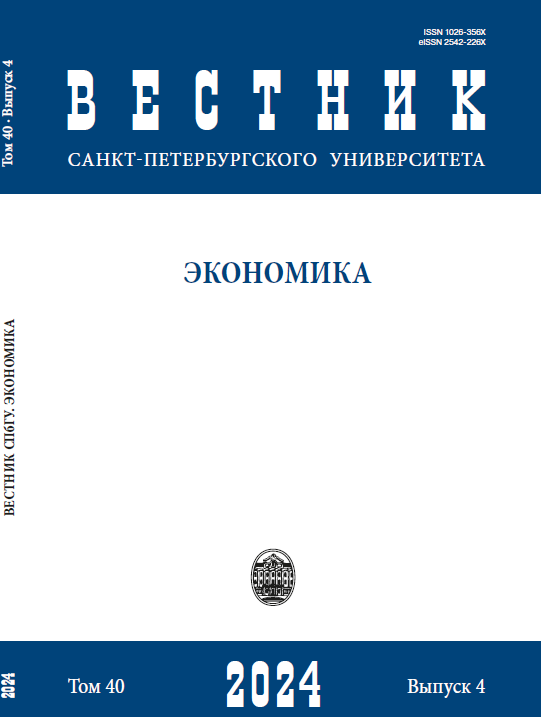Agglomeration effects in the industrial development of the Republic of Korea
DOI:
https://doi.org/10.21638/spbu05.2024.403Abstract
The article is dedicated to assessing the impact of agglomeration effects on various sectors of the South Korean economy and manufacturing at modern times. To do this, based on the analysis of theoretical approaches and empirical studies of agglomeration effects in other countries, the most appropriate assessment method was selected that uses the Cobb-Douglas function. The concentration of economic activity is expected to have a significant impact on productivity in most sectors of the Korean economy. At the same time, more high-tech industries should benefit more from agglomeration of urbanization, while others benefit from concentration in specialized areas. It was determined that agglomeration effects have a significant impact on Korean economy and manufacturing, comparable to the results of previous empirical studies in Europe and North America. The negative impact of agglomeration is observed in agriculture, and various services are practically not at all affected by agglomeration. Contrary to expectations, agglomeration in Korea does not have such a strong impact on the finance and insurance, as in other countries. The positive impact of Marshall (MAR) agglomeration economies, that is, due to the concentration of enterprises in one industry, is maximum for wholesale and retail trade, real estate, information and communication technologies (ICT) and the mining industry. Real estate and ICT also benefit the most from agglomeration of urbanization (Jacobs effects) — the concentration of firms from different industries. For the Korean manufacturing industry, agglomeration of localization is more important, especially for the chemical industry and metallurgy, while agglomeration of urbanization is significant only for more high-tech industries (electronics, transport engineering). The results are significant for the development of regional and sectoral development strategies for countries already using the Korean experience or wishing to adopt certain successful mechanisms for optimizing regional industrial development policy.
Keywords:
agglomeration externalities, MAR-effects, Jacobs effects, regression analysis, Republic of Korea, manufacturing
Downloads
References
Arrow, K. J. (1971) The economic implications of learning by doing. Readings in the Theory of Growth. London:Palgrave Macmillan.
Beaudry, C. and Schiffauerova, A. (2009) ‘Who’s right, Marshall or Jacobs? The localization versus urbanization debate’, Research Policy, 38 (2), pp. 318–337. https://doi.org/10.1016/j.respol.2008.11.010
Ciccone, A. (2002) ‘Agglomeration effects in Europe’, European Economic Review, 46 (2), pp. 213–227. https://doi.org/10.1016/S0014 2921(00)00099-4
Ciccone, A. and Hall, R. E. (1993) ‘Productivity and the density of economic activity’, American Economic Review, 86 (1), pp. 54–70.
Duranton, G. and Puga, D. (2004) ‘Micro‑foundations of urban agglomeration economies’, Handbook of Regional and Urban Economics, 4, pp. 2063–2117. https://doi.org/10.1016/S1574-0080(04)80005-1
Ellison, G., Glaeser, E. L. and Kerr, W. R. (2010) ‘What causes industry agglomeration? Evidence from coagglomeration patterns’, American Economic Review, 100 (3), pp. 1195–1213. https://doi.org/10.1257/aer.100.3.1195
Finney, M. M. and Kohlhase, J. E. (2008) ‘The effect of urbanization on labor turnover’, Journal of Regional Science, 48 (2), pp. 311–328. https://doi.org/10.1111/j.1467-9787.2008.00553.x
Fujita, M. and Thisse, J. F. (2013) Economics of agglomeration: Cities, industrial location and globalization. Cambridge: Cambridge University Press.
Fukao, K., Kravtsova, V. and Nakajima, K. (2014) ‘How important is geographical agglomeration to factory efficiency in Japan’s manufacturing sector?’, The Annals of Regional Science, 52 (3), pp. 659–696. https://doi.org/10.1007/s00168-014-0601-9
Glaeser, E. L., Kallal, H. D., Scheinkman, J. A. and Shleifer, A. (1992) ‘Growth in cities’, Journal of Political Economy, 100 (6), pp. 1126–1152. https://doi.org/10.1086/261856
Gordeev, V., Magomedov, R. and Mikhaylova T. (2017) ‘Agglomeration effects in Russian manufacturing,Ekonomicheskoe Razvitie Rossii, 24 (8), pp. 19–20. (In Russian)
Graham, D. J. and Van Dender, K. (2011) ‘Estimating the agglomeration benefits of transport investments: Some tests for stability’, Transportation, 38 (3), pp. 409–426. https://doi.org/10.1007/s11116-010-9310-0
Griliches, Z. (1992) ‘The search for R&D spillovers’, Scandinavian Journal of Economics, pp. 29–47.
Guo, Q., He, C. and Li, D. (2016) ‘Entrepreneurship in China: The role of urbanization and urbanization economies’, Urban Studies, 53 (12), pp. 2584–2606. https://doi.org/10.1177/0042098015595598
Henderson, J. V. (1986) ‘Efficiency of resource usage and city size’, Journal of Urban Economics, 19 (1),pp. 47–70. https://doi.org/10.1016/0094-1190(86)90030-6
Henderson, J. V. (1991) Urban development: Theory, fact, and illusion. Oxford: OUP Catalogue.
Henderson, V., Lee, T. and Lee, Y. J. (2001) ‘Scale externalities in Korea’, Journal of Urban Economics, 49 (3),pp. 479–504. https://doi.org/10.1006/juec.2000.2202
Jacobs, J. (2016) The economy of cities. New York: Vintage.
Krugman, P. (1991) Geography and trade. Cambridge: MIT Press.
Lee, B. S., Jang, S. and Hong, S. H. (2010) ‘Marshall’s scale economies and Jacobs’ externality in Korea: The role of age, size and the legal form of organization of establishments’, Urban Studies, 47 (14), pp. 3131–3156. https://doi.org/10.1177/0042098009359953
Mano, Y. and Otsuka, K. (2000) ‘Agglomeration economies and geographical concentration of industries: a case study of manufacturing sectors in postwar Japan’, Journal of the Japanese and International Economies, 14 (3), pp. 189–203. https://doi.org/10.1006/jjie.2000.0449
Marshall, A. (2009) Principles of economics: Unabridged eighth edition. New York: Cosimo, Inc.
Melo, P. C., Graham, D. J., Levinson, D. and Aarabi, S. (2017) ‘Agglomeration, accessibility and productivity: Evidence for large metropolitan areas in the US’, Urban Studies, 54 (1), pp. 179–195. https://doi.org/10.1177/0042098015624850
Nakamura, R. (2008) ‘Agglomeration effects on regional economic disparities: A comparison between the UK and Japan’, Urban Studies, 45 (9), pp. 1947–1971. https://doi.org/10.1177/0042098008093385
Romer, P. M. (1986) ‘Increasing returns and long‑run growth’, Journal of Political Economy, 94 (5), pp. 1002–1037. https://doi.org/10.1086/261420
Saxenian, A. (1994) Regional advantage: Culture and competition in Silicon Valley and Route 128. Cambridge:Harvard University Press.
Solow, R. M. (1957) ‘Technical change and the aggregate production function’, The Review of Economics and Statistics, 39 (3), pp. 312 320. https://doi.org/10.2307/1926047
Sveikauskas, L. (1975) ‘The productivity of cities’, The Quarterly Journal of Economics, 89 (3), pp. 393–413. https://doi.org/10.2307/1885259
Wetwitoo, J. and Kato, H. (2017) ‘Inter‑regional transportation and economic productivity: A case study of regional agglomeration economies in Japan’, The Annals of Regional Science, 59 (2), pp. 321–344. https://doi.org/10.1007/s00168-017-0833-6
Downloads
Published
How to Cite
Issue
Section
License
Articles of the St Petersburg University Journal of Economic Studies are open access distributed under the terms of the License Agreement with Saint Petersburg State University, which permits to the authors unrestricted distribution and self-archiving free of charge.






